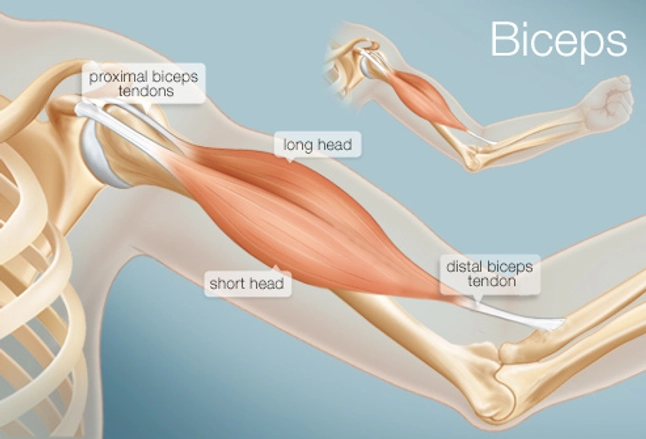Picture of the Biceps

The biceps is a muscle on the front part of the upper arm. The biceps includes a “short head” and a “long head” that work as a single muscle.
The biceps is attached to the arm bones by tough connective tissues called tendons. The tendons that connect the biceps muscle to the shoulder joint in two places are called the proximal biceps tendons. The tendon that attaches the biceps muscle to the forearm bones (radius and ulna) is called the distal biceps tendon. When the biceps contracts, it pulls the forearm up and rotates it outward.
Biceps Conditions
- Biceps strain: A pulled biceps results from overstretching and tearing some of the biceps muscle fibers and/or tendons. Pain and sometimes swelling are the usual symptoms.
- Proximal biceps tendon rupture: This is when one of the two biceps tendons in the shoulder is torn away from the bone. Sudden shoulder pain and an odd-shaped bulge in the biceps are symptoms.
- Distal biceps tendon rupture: A tear of the biceps tendon at the forearm is unusual. Sudden pain over the front of the elbow and forearm weakness are symptoms.
- Proximal biceps tendinitis (tendonitis): Repeated use of the biceps or problems in the shoulder can irritate the proximal biceps tendon. Pain in the shoulder and biceps is the main symptom.
- Biceps contracture: The biceps becomes permanently contracted, with the elbow bent. Biceps contracture may occur after a severe stroke.
Biceps Tests
- Physical examination: By examining and palpating (feeling) the biceps while it is moved into various positions, a health care provider collects clues to possible biceps conditions.
- Speed’s test: A person holds their arm out with their elbow slightly bent and their palm up, while the health care provider presses downward on the arm. Pain in a specific area of the shoulder during Speed’s test suggests biceps tendinitis.
- Yergason’s test: A person bends the elbow 90 degrees (at a right angle) while gripping hands with the health care professional, who applies pressure to the arm. Pain in a specific shoulder area during the test suggests biceps tendinitis.
- Computed tomography (CT scan): A CT scanner takes multiple X-rays, and a computer compiles them into images of the interior of the biceps and nearby structures.
- Magnetic resonance imaging (MRI scan): An MRI scanner uses a high-powered magnet and a computer to create highly detailed images of the biceps and surrounding structures.
- Biceps ultrasound: A device placed on the surface of the skin bounces high-frequency sound waves off structures in the biceps. The signals are converted into images on a video screen, allowing health care providers to see structures inside the body. Biceps ultrasound may help identify biceps tendon problems.








لا يوجد تعليقات
أضف تعليق